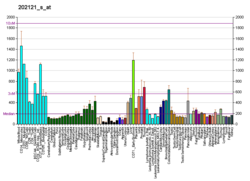| CHMP2A |
|---|
|
| Identifiers |
|---|
| Aliases | CHMP2A, BC-2, BC2, CHMP2, VPS2, VPS2A, charged multivesicular body protein 2A |
|---|
| External IDs | OMIM: 610893; MGI: 1916203; HomoloGene: 6382; GeneCards: CHMP2A; OMA:CHMP2A - orthologs |
|---|
| Gene location (Human) |
|---|
 | | Chr. | Chromosome 19 (human)[1] |
|---|
| | Band | 19q13.43 | Start | 58,551,452 bp[1] |
|---|
| End | 58,555,105 bp[1] |
|---|
|
| Gene location (Mouse) |
|---|
 | | Chr. | Chromosome 7 (mouse)[2] |
|---|
| | Band | 7 A1|7 | Start | 12,765,937 bp[2] |
|---|
| End | 12,768,734 bp[2] |
|---|
|
| RNA expression pattern |
|---|
| Bgee | | Human | Mouse (ortholog) |
|---|
| Top expressed in | - mucosa of transverse colon
- right adrenal gland
- right adrenal cortex
- left adrenal gland
- left adrenal cortex
- oral cavity
- olfactory zone of nasal mucosa
- skin of leg
- apex of heart
- gastric mucosa
|
| | Top expressed in | - corneal stroma
- saccule
- seminal vesicula
- superior surface of tongue
- arcuate nucleus
- olfactory epithelium
- neural layer of retina
- left colon
- otic vesicle
- skin of external ear
|
| | More reference expression data |
|
|---|
| BioGPS |  | | More reference expression data |
|
|---|
|
| Gene ontology |
|---|
| Molecular function | - protein domain specific binding
- phosphatidylcholine binding
- protein binding
| | Cellular component | - cytosol
- endosome
- membrane
- late endosome membrane
- membrane coat
- extracellular exosome
- ESCRT III complex
- nuclear envelope
- chromatin
- multivesicular body
| | Biological process | - regulation of centrosome duplication
- protein polymerization
- viral budding via host ESCRT complex
- protein heterooligomerization
- nucleus organization
- viral life cycle
- establishment of protein localization
- negative regulation of centriole elongation
- membrane invagination
- multivesicular body assembly
- negative regulation of cell death
- regulation of mitotic spindle assembly
- endosomal transport
- transport
- protein transport
- positive regulation of exosomal secretion
- septum digestion after cytokinesis
- mitotic metaphase plate congression
- protein homooligomerization
- vacuolar transport
- regulation of viral process
- ESCRT III complex disassembly
- nuclear membrane reassembly
- exit from mitosis
- macroautophagy
- endosome transport via multivesicular body sorting pathway
- late endosome to vacuole transport
- midbody abscission
| | Sources:Amigo / QuickGO |
|
| Orthologs |
|---|
| Species | Human | Mouse |
|---|
| Entrez | | |
|---|
| Ensembl | | |
|---|
| UniProt | | |
|---|
| RefSeq (mRNA) | | |
|---|
NM_026885
NM_001360730
NM_001360731
NM_001360733 |
|
|---|
| RefSeq (protein) | | |
|---|
NP_081161
NP_001347659
NP_001347660
NP_001347662 |
|
|---|
| Location (UCSC) | Chr 19: 58.55 – 58.56 Mb | Chr 7: 12.77 – 12.77 Mb |
|---|
| PubMed search | [3] | [4] |
|---|
|
| Wikidata |
| View/Edit Human | View/Edit Mouse |
|


















